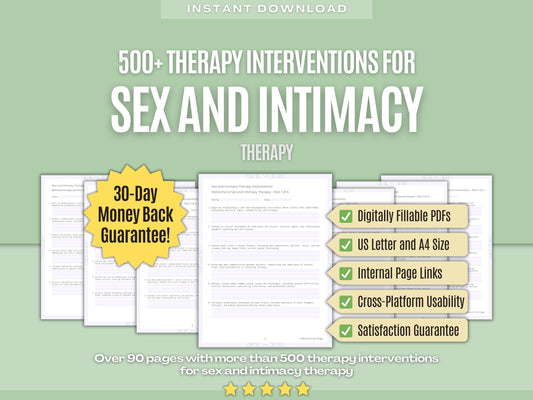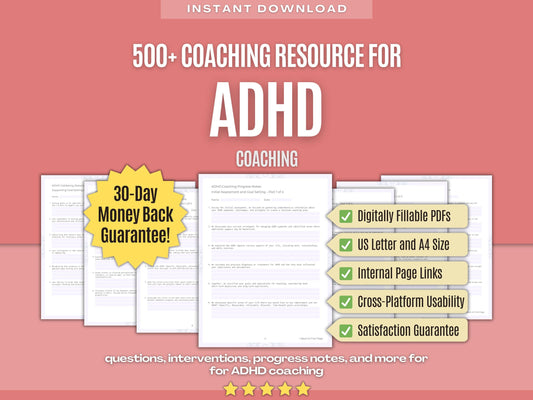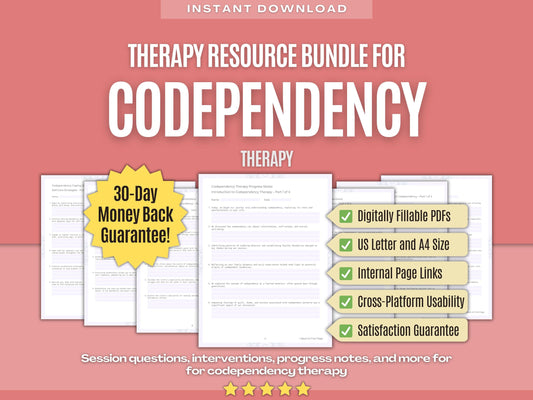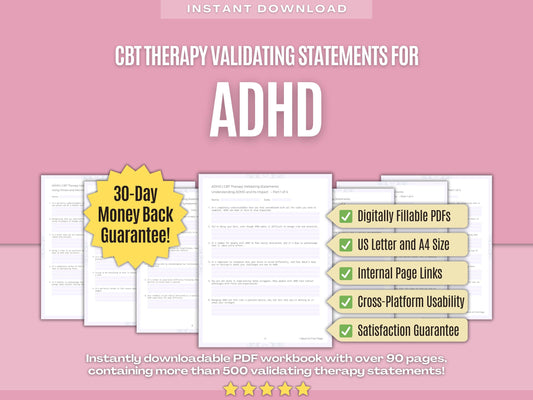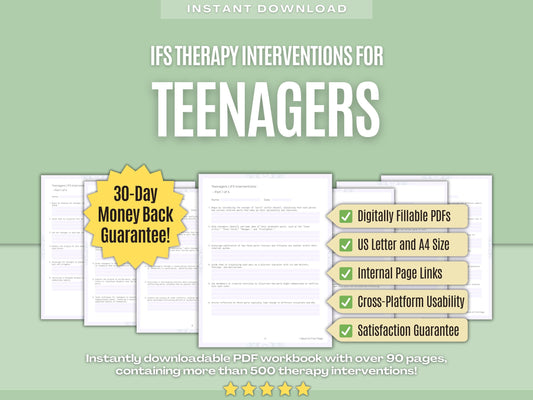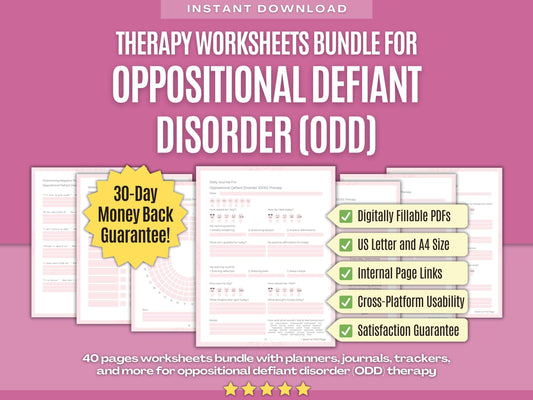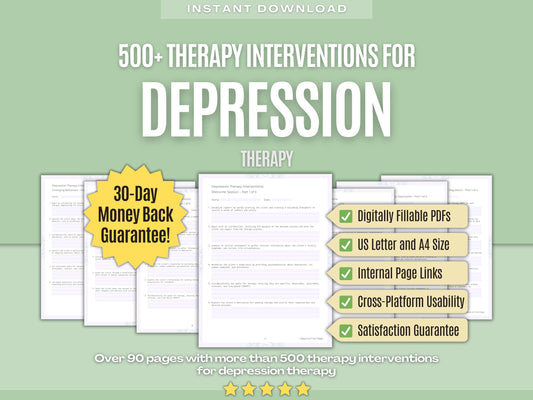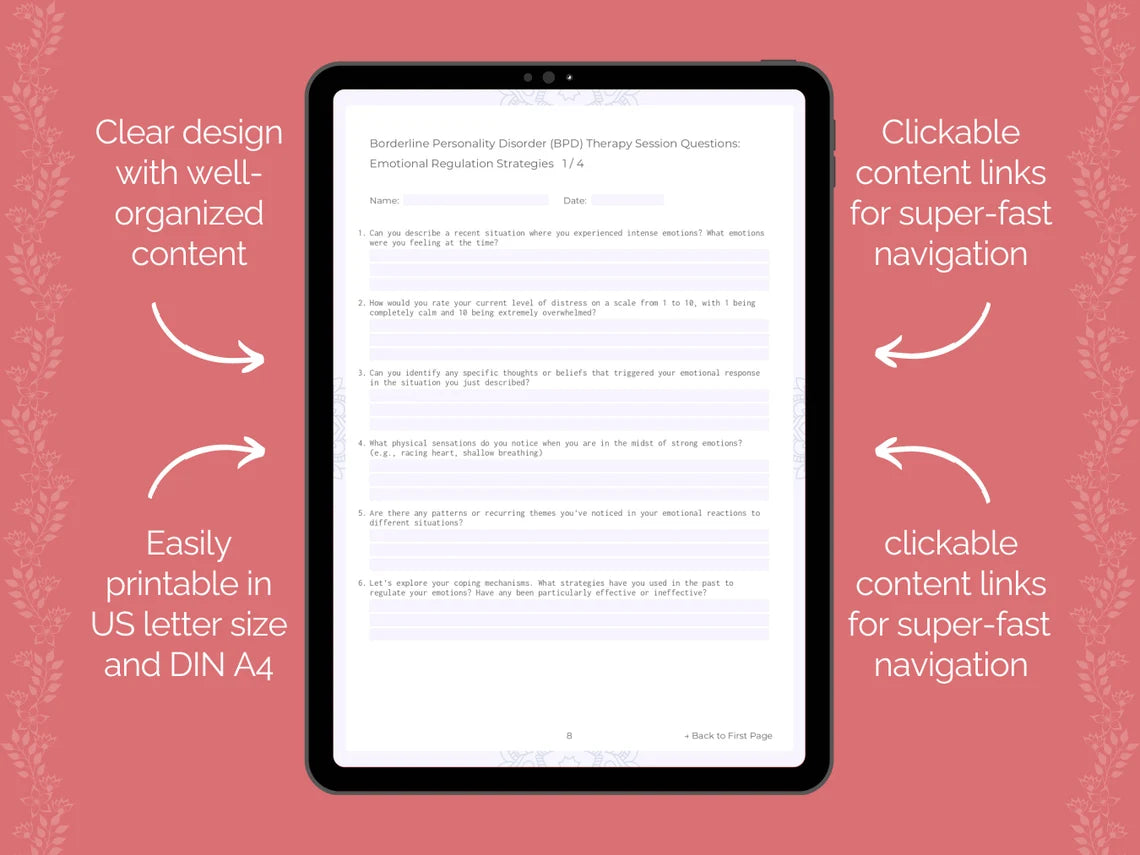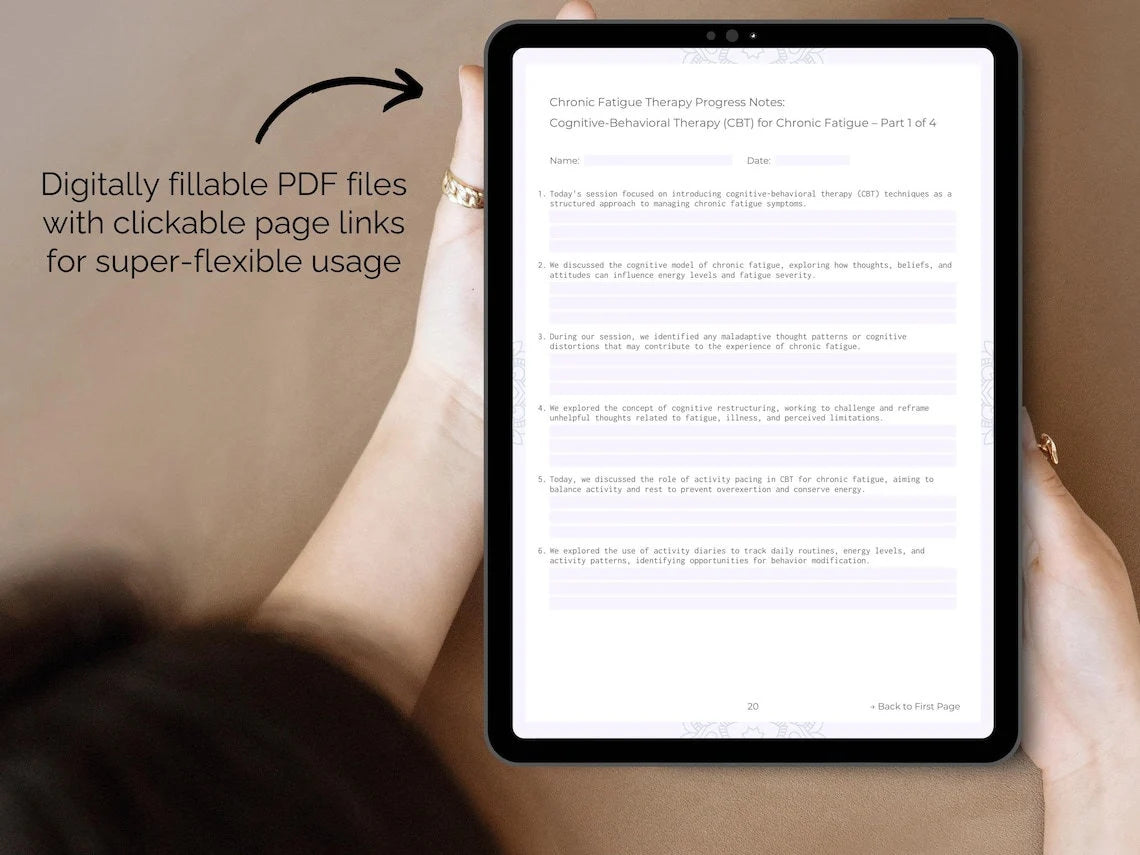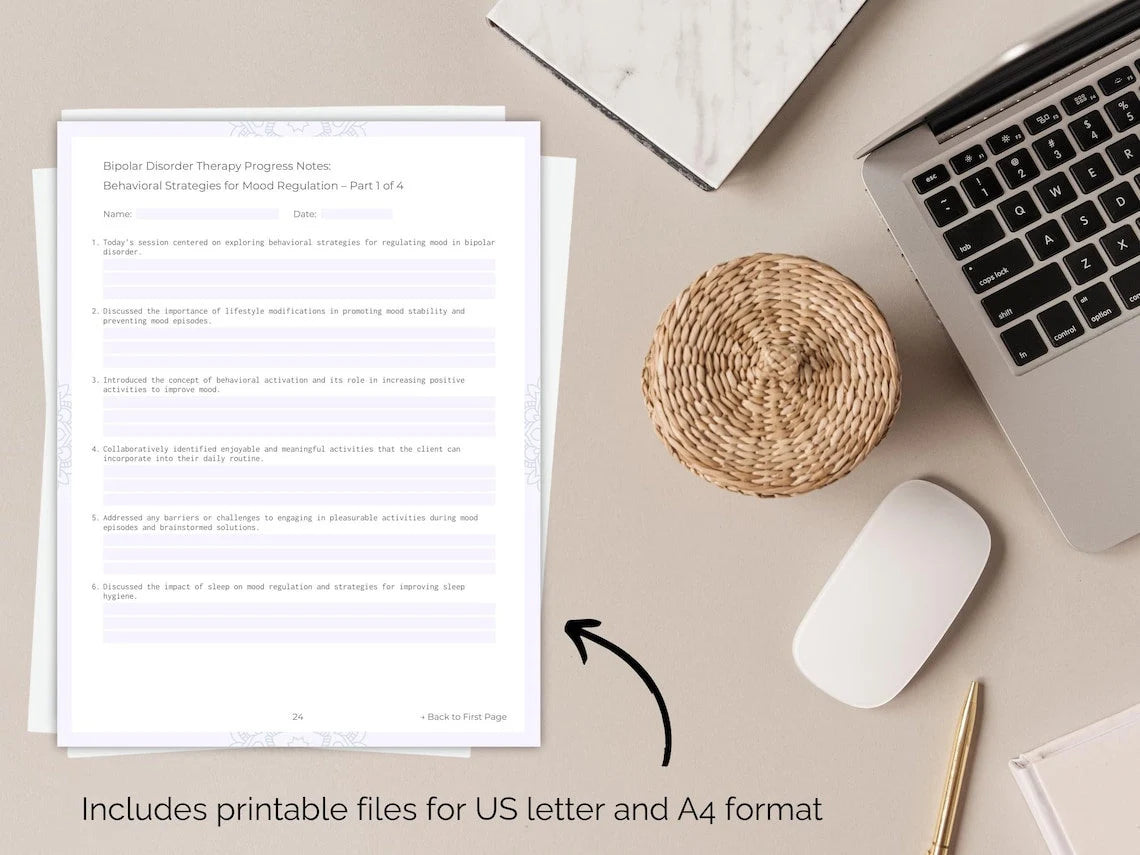Elevate Your Therapy and Guide Your Clients to Inner Healing with Our Depression Therapy Interventions! ✨
1. Starting Your Journey
- Begin by establishing rapport and creating a supportive environment where the client feels comfortable sharing their experiences.
- Conduct an initial assessment to gather information about the client's history, symptoms, and current challenges related to depression.
- Explore the client's motivations for seeking therapy and clarify their goals and expectations for treatment.
- Assess the client's strengths and resilience factors, highlighting areas of resilience that can be leveraged in their journey towards recovery.
- Explore the client's support system, including friends, family, or other resources that can provide assistance and encouragement.
- Provide psychoeducation about evidence-based treatment options for depression, such as cognitive-behavioral therapy (CBT), medication, or other therapeutic modalities.
- Foster hope by highlighting examples of successful outcomes from previous clients or research studies.
- Educate the client about the importance of self-care practices, including sleep hygiene, nutrition, and physical activity.
- Assess for any potential risk factors, such as suicidal ideation, and create a safety plan if necessary.
- Encourage the client to engage in activities that bring them joy or a sense of accomplishment, even if they initially feel unmotivated.
- Teach coping skills for managing depressive symptoms, such as problem-solving techniques or behavioral activation strategies.
Need more? Find all 500+ Therapy Interventions for Depression Therapy in our Digital Workbook!
2. Understanding Depression
- Begin by providing psychoeducation about depression, including its definition, common symptoms, and potential causes.
- Help the client identify and label their specific symptoms of depression, such as changes in mood, energy levels, or sleep patterns.
- Discuss the biopsychosocial model of depression, highlighting the interplay between biological, psychological, and social factors.
- Explore the role of genetics and family history in predisposing individuals to depression, if relevant.
- Introduce the concept of cognitive distortions or negative thinking patterns commonly associated with depression, such as black-and-white thinking or self-blame.
- Explore the client's beliefs about themselves, the world, and the future, and how these beliefs may influence their depressive symptoms.
- Explore the client's coping mechanisms for dealing with stress or difficult emotions, identifying both adaptive and maladaptive strategies.
- Discuss the potential benefits and limitations of pharmacological interventions for depression, such as antidepressant medications.
- Introduce behavioral activation techniques to help the client increase engagement in rewarding activities and improve mood.
- Teach the client relaxation techniques, such as deep breathing or progressive muscle relaxation, to help alleviate symptoms of anxiety and tension.
- Assess for any co-occurring mental health conditions, such as anxiety or substance use disorders, and discuss their potential impact on depression treatment.
Need more? Find all 500+ Therapy Interventions for Depression Therapy in our Digital Workbook!
3. Practicing Mindfulness
- Begin by introducing the concept of mindfulness, explaining it as the practice of paying attention to the present moment without judgment.
- Explore the client's current understanding and previous experiences with mindfulness, addressing any misconceptions or skepticism they may have.
- Guide the client through a mindfulness meditation practice, encouraging them to focus on their breath or bodily sensations and gently redirecting attention when it wanders.
- Introduce mindful movement practices, such as yoga or walking meditation, as alternative ways to cultivate mindfulness and embodiment.
- Explore the connection between mindfulness and self-compassion, emphasizing the importance of treating oneself with kindness and understanding.
- Explore informal mindfulness practices, such as mindful eating or mindful listening, that can be integrated into daily life activities.
- Collaboratively problem-solve strategies to overcome obstacles to mindfulness practice, such as setting realistic goals or incorporating mindfulness into existing routines.
- Explore the connection between mindfulness and values-based living, encouraging clients to align their actions with their core values and priorities.
- Guide clients in developing a personalized mindfulness practice plan, including specific exercises or activities that resonate with their preferences and needs.
- Explore the connection between mindfulness and relapse prevention, teaching clients how to apply mindfulness techniques to prevent depressive relapse.
- Encourage clients to cultivate a beginner's mind, approaching mindfulness practice with openness, curiosity, and a willingness to learn.
Need more? Find all 500+ Therapy Interventions for Depression Therapy in our Digital Workbook!
4. Dialectical Behavior Therapy (DBT) for Mood Regulation
- Begin by introducing the principles of Dialectical Behavior Therapy (DBT) for mood regulation, emphasizing the balance between acceptance and change.
- Collaboratively identify specific emotional triggers or patterns of dysregulation that contribute to the client's depression, such as intense anger or chronic sadness.
- Teach clients emotion regulation skills to help them identify and label their emotions, understand the functions of emotions, and modulate emotional intensity.
- Collaboratively develop a crisis survival plan with the client, including strategies for managing emotional crises and accessing support during times of distress.
- Discuss the connection between self-compassion and mood regulation, encouraging clients to treat themselves with kindness and understanding during difficult times.
- Teach clients interpersonal skills to help them build and maintain healthy relationships, reduce feelings of loneliness or isolation, and increase social support.
- Introduce behavioral activation techniques to help clients increase engagement in rewarding activities and counteract withdrawal and avoidance behaviors.
- Teach clients problem-solving skills to help them effectively cope with challenges and stressors in their lives, reducing feelings of helplessness and hopelessness.
- Introduce the concept of wise mind, helping clients integrate their emotional and rational minds to make balanced and effective decisions.
- Teach clients the STOP skill to interrupt impulsive or harmful behaviors, encouraging them to pause, take a step back, observe their thoughts and emotions, and proceed mindfully.
- Discuss the importance of building mastery and accumulating positive experiences to enhance self-esteem and promote mood stability.
Need more? Find all 500+ Therapy Interventions for Depression Therapy in our Digital Workbook!
5. Interpersonal Therapy (IPT) for Relationships
- Begin by conducting a thorough assessment of the client's current interpersonal relationships, including family, friends, romantic partners, and colleagues.
- Use the "Interpersonal Inventory" technique to explore the client's past and present relationships, identifying patterns of interaction and areas for improvement.
- Explore the client's communication style and interpersonal skills, identifying areas where they may need support or development.
- Use role-playing exercises to practice effective communication strategies, conflict resolution techniques, and assertiveness skills.
- Explore the client's attachment style and how it may influence their interpersonal dynamics and relationship patterns.
- Encourage the client to reach out to supportive friends or family members for social support and connection outside of therapy.
- Explore the client's social support network, identifying sources of strength and resilience that they can draw upon during difficult times.
- Use the "Role Transition" technique to explore significant life changes or transitions that may be impacting the client's relationships, such as marriage, divorce, or career changes.
- Explore the impact of cultural or societal norms on the client's relationships and identity, validating their unique experiences and perspectives.
- Foster forgiveness and acceptance in the therapeutic process, helping the client let go of resentment or bitterness towards others.
- Use mindfulness and relaxation techniques to help the client manage stress and anxiety in their interpersonal interactions.
Need more? Find all 500+ Therapy Interventions for Depression Therapy in our Digital Workbook!
6. Emotion-Focused Therapy (EFT) for Emotional Healing
- Begin by creating a safe and supportive therapeutic environment where the client feels comfortable exploring their emotions without judgment.
- Use the "Empty Chair Technique" to facilitate dialogue between different aspects of the client's emotional self or to explore unresolved emotions.
- Explore the client's emotional history and early attachment experiences to gain insight into the roots of their current emotional patterns.
- Foster empathy and validation in the therapeutic relationship, helping the client feel understood and accepted in their emotional struggles.
- Encourage the client to practice mindfulness and present moment awareness to observe their emotions without becoming overwhelmed by them.
- Use the "Coping Repertoire" technique to help the client identify adaptive strategies for managing their emotions in healthy ways.
- Use emotion-focused imagery rescripting to help the client reprocess traumatic or distressing memories in a way that promotes emotional healing.
- Use the "Emotion Cycle" technique to help the client track the progression of their emotions over time and identify patterns or triggers.
- Foster exploration of the client's emotional vulnerabilities and fears, helping them build resilience and coping strategies.
- Encourage the client to identify and challenge unhelpful or distorted beliefs about their emotions, such as the idea that certain feelings are "bad" or "wrong."
- Use metaphorical or symbolic language to help the client externalize and explore their emotions in a non-threatening way.
Need more? Find all 500+ Therapy Interventions for Depression Therapy in our Digital Workbook!
7. Psychodynamic Exploration of Underlying Issues
- Encourage the client to explore early childhood experiences that may have contributed to their current patterns of thinking and behavior.
- Guide the client in examining their relationships with significant figures from their past, such as parents or caregivers, to identify any unresolved conflicts or traumas.
- Assist the client in identifying recurring themes or patterns in their life that may be contributing to their depression.
- Help the client recognize and challenge negative internalized beliefs or self-perceptions that may be rooted in early experiences.
- Guide the client in exploring any unresolved grief or loss experiences that may be contributing to their depression.
- Encourage the client to explore their relationship with authority figures and how it may affect their sense of autonomy and self-esteem.
- Help the client recognize and process any feelings of guilt or shame that may be contributing to their depressive symptoms.
- Guide the client in exploring unresolved conflicts or unmet needs from childhood that may be contributing to their depression.
- Encourage the client to explore the role of family dynamics in shaping their sense of identity and self-worth.
- Help the client recognize and challenge any internalized negative messages or beliefs acquired during childhood.
- Guide the client in exploring their early experiences of love and intimacy and how they may influence their current relationships.
Need more? Find all 500+ Therapy Interventions for Depression Therapy in our Digital Workbook!
8. Soothing with Music Therapy
- Begin by inviting clients to create personalized playlists of music that resonate with their emotions and experiences, encouraging them to explore different genres, artists, and songs.
- Incorporate guided imagery exercises paired with music, where clients visualize soothing scenes or positive experiences while listening to carefully selected music tracks.
- Utilize music-assisted relaxation techniques, such as autogenic training or guided visualization, to help clients achieve a state of deep relaxation and reduce symptoms of anxiety and tension.
- Introduce the concept of music journaling, where clients reflect on their emotional responses to music and explore the connections between music and their inner experiences.
- Guide clients in creating personalized affirmations or mantras set to music, allowing them to internalize positive messages and cultivate a sense of self-compassion and empowerment.
- Explore the use of guided music listening sessions, where clients listen to specific pieces of music chosen for their therapeutic qualities and discuss their emotional responses with the therapist.
- Encourage clients to create artwork inspired by music, using drawing, painting, or collage to visually represent their emotional responses and associations with specific songs or musical genres.
- Incorporate music-assisted guided relaxation exercises, such as progressive muscle relaxation or body scan meditation, where clients listen to calming music while focusing on releasing tension from different parts of their body.
- Introduce the use of binaural beats or brainwave entrainment music to help clients achieve specific states of consciousness, such as relaxation, focus, or sleep induction.
- Incorporate music-assisted mindfulness exercises, such as mindful listening or walking meditation with music, to help clients cultivate present moment awareness and deepen their connection to the music and themselves.
- Introduce the use of guided music imagery scripts, where clients listen to specific pieces of music while visualizing calming or empowering scenes, to promote relaxation and emotional well-being.
Need more? Find all 500+ Therapy Interventions for Depression Therapy in our Digital Workbook!
9. Reflecting on Progress
- Begin by encouraging clients to keep a journal or diary where they can regularly record their thoughts, feelings, and experiences related to their therapeutic journey and progress.
- Utilize scaling questions to help clients assess and track their progress over time, asking them to rate their mood, energy levels, and overall well-being on a scale from 1 to 10.
- Guide clients in creating a visual representation of their progress, such as a timeline or collage, incorporating images, words, and symbols that reflect milestones, achievements, and moments of growth.
- Encourage clients to identify and celebrate small victories and achievements, such as completing tasks, engaging in self-care activities, or challenging negative thought patterns.
- Introduce mindfulness-based practices, such as body scans or mindful breathing exercises, to help clients cultivate awareness and acceptance of their present moment experience, including their progress in therapy.
- Incorporate goal-setting exercises into therapy sessions, helping clients identify specific, achievable goals related to their treatment and recovery, and develop action plans to work towards them.
- Encourage clients to seek feedback from trusted friends, family members, or support networks about the changes they have observed in themselves since starting therapy, providing an external perspective on their progress.
- Explore the concept of self-compassion with clients, helping them cultivate kindness and understanding towards themselves as they navigate their depression treatment journey.
- Introduce the concept of resilience and the idea that setbacks and challenges are a natural part of the progress process, helping clients build confidence in their ability to bounce back and continue moving forward.
- Encourage clients to reflect on the coping strategies and skills they have developed throughout their therapy journey, recognizing their resilience and capacity for growth.
- Introduce the concept of self-compassion letters, where clients write letters to themselves expressing kindness, encouragement, and support during difficult times, fostering a sense of self-acceptance and resilience.
Need more? Find all 500+ Therapy Interventions for Depression Therapy in our Digital Workbook!
10. Looking Forward
- Begin by engaging clients in a visioning exercise where they imagine their ideal future selves, exploring aspects such as their career, relationships, hobbies, and overall well-being.
- Utilize goal-setting techniques to help clients establish concrete, achievable goals for their future, breaking them down into smaller, manageable steps to increase motivation and accountability.
- Explore the concept of life purpose and meaning with clients, encouraging them to reflect on what gives their life meaning and how they can align their actions with their deepest values and aspirations.
- Encourage clients to explore their passions and interests, helping them reconnect with activities and pursuits that bring them joy, fulfillment, and a sense of purpose.
- Facilitate discussions about career exploration and vocational goals, helping clients identify their strengths, interests, and values to inform their career choices and aspirations.
- Guide clients in creating a vision board or collage that represents their hopes, dreams, and goals for the future, using images, words, and symbols to visualize their desired outcomes.
- Integrate mindfulness-based practices into therapy sessions to help clients stay present and focused on their future goals, while also fostering self-awareness and emotional regulation.
- Introduce the concept of self-care planning, helping clients develop personalized strategies and routines to support their mental, emotional, and physical well-being as they work towards their future aspirations.
- Encourage clients to explore opportunities for personal growth and development, such as workshops, classes, or volunteer work, that align with their interests and goals for the future.
- Guide clients in exploring potential barriers or obstacles to achieving their goals, helping them develop contingency plans and problem-solving strategies to navigate challenges effectively.
- Explore the concept of meaningful activities and routines with clients, helping them establish habits and practices that support their well-being and contribute to a sense of purpose and fulfillment in their daily lives.
We hope that our therapy interventions for Depression therapy will help you to elevate your therapy practice and guide your clients to inner healing! Do you need more therapy interventions for Depression therapy? Find them all in our Digital Workbook! Or do you have any questions or suggestions for us? Please feel free to contact us at any time!

